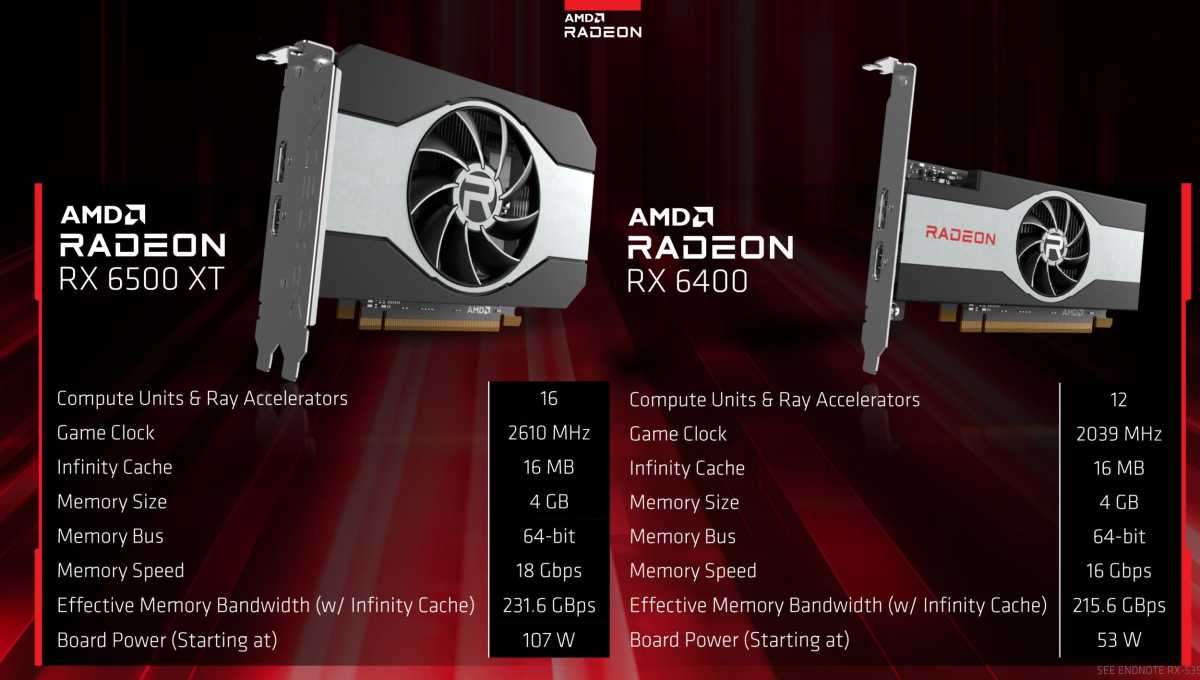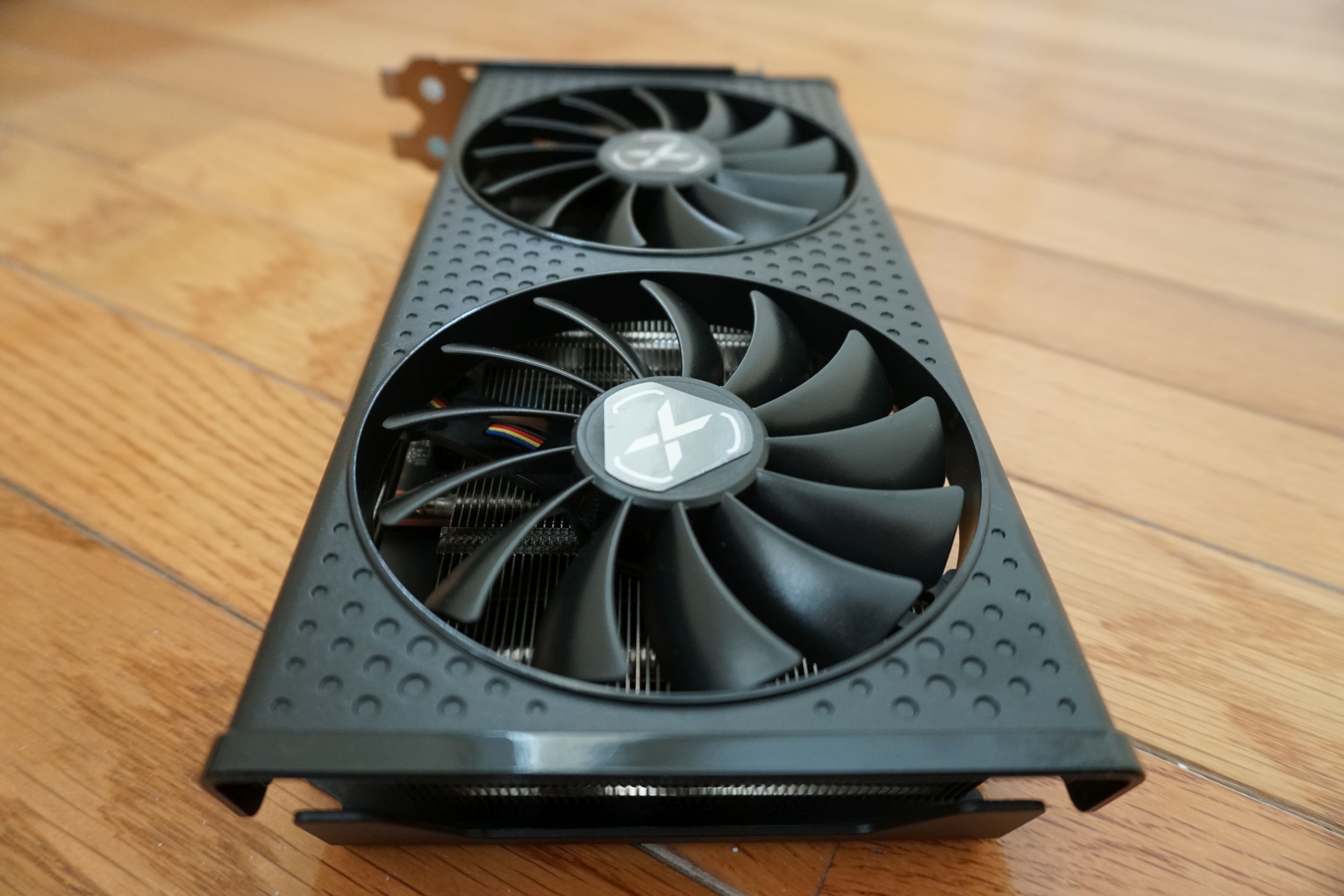Skimming through the endless reviews slamming AMD’s new $199 Radeon RX 6500 XT this week, you might think the affordable graphics card is nothing short of an abomination. “Worst GPU!” Hardware Unboxed’s video title screamed. “Worse Than 2016’s GPUs,” Gamers Nexus declared. “A GPU you might be able to buy… But shouldn’t,” Linus Tech Tips proclaimed. The list goes on.
Here’s the thing though: While those perspectives are all absolutely valid and true—AMD’s graphics card is a bizarre creature indeed, and one that doesn’t move the performance needle over prior GPU generations, as I explained in my own Radeon RX 6500 XT review—I feel they’re missing some crucial perspective. It ain’t 2016 anymore and the world needs affordable graphics cards right now. If it can stay in stock, the Radeon RX 6500 XT scratches that itch.
[ Further reading: AMD’s $199 Radeon RX 6500 XT tested: 5 key things you need to know ]
Yes, AMD cut features hard to make the Radeon RX 6500 XT a reality, and those choices make the new GPU less appealing than yesteryear’s $150 to $250 graphics cards. It has only four PCIe 4.0 lanes, which work just fine in a modern PC but can throttle performance in older PCIe 3.0-based systems. The paltry memory configuration—just 4GB, over a barely-there 64-bit bus, though augmented by 16MB of AMD’s radical on-GPU Infinity Cache tech—inhibits the card’s visual potential as well. AMD also eradicated encoding support for H.264 and H.265/HEVC, which streamers rely on, and outfit the Radeon RX 6500 XT with just one HDMI 2.1 connection and one DisplayPort. So yes, those disappointed reviewers have every reason to be disappointed. By many objective metrics, the Radeon RX 6500 XT is worse than prior budget graphics cards.
But!
The world is a different place as we enter year three of this damned pandemic. Graphics cards are all but impossible to find at sane prices right now, thanks to a mixture of ongoing component shortages, logistics woes, raised tariffs, booming GPU demand by cryptocurrency miners seeking profits, and more. Even used versions of those comparable older GPUs (like the Radeon RX 580 and 5500 XT, and Nvidia’s GeForce GTX 1650 Super and GTX 1060) usually sell for $250 to $400 on Ebay, depending on the day and details.

AMD
It’s bad, y’all. So bad that last year, we resorted to recommending AMD’s Ryzen 5000 CPUs with decent integrated graphics as the best budget option in our graphics card buying guide. Hell, we even went so far as to crown those integrated graphics as the best GPU of 2021. We’re discrete GPU elitists here at PCWorld, but I found myself telling gamers on a budget to pick up a console or try GeForce Now streaming instead these last several months. We haven’t seen a new budget GPU released since 2019!
It couldn’t have happened at a worse time. Stuck in their homes, a new generation was introduced to the glory of gaming in the midst of all this. My ex works at an elementary school, and the kids there know what I do for a living. I’ve fielded infinitely more “What’s a good way to get a cheap PC to play Fortnite with the homies?” queries since lockdown began than I had in the entirety of The Before Times. My sad answer: There isn’t one. Get an iPad. My high school daughter’s boyfriend works part-time washing dishes and dabbles in creating OG Doom mods on the side. His graphics card fried early in 2021 and he spent all summer saving pennies and looking for an affordable replacement. None existed. (Fortunately, when I heard about the dilemma I had an old GTX 900-series card I could give him.) Plenty of new adult gamers have been left empty handed, too.
And that is why I can’t be anywhere near as negative about the Radeon RX 6500 XT as many of my reviewer colleagues have been.
Sure, the card can start to choke if you push it beyond its limits, cranking up eye candy to the max or bumping your resolution past 1080p. But if you stick to 1080p gaming, you’ll be able to play competitive e-sports games at a blazing-fast pace or enjoy triple-A titles at Medium to High settings at a solid 60 frames-per-second-plus—even on a PCIe 3.0 system. Is the Radeon RX 6500 XT a compelling upgrade over prior budget cards? No. But it exists, and that hasn’t been true in the budget space for years now. Again: Used Radeon RX 580s from 2017 are going for $250 to $400 on the streets, and that’s after five years of being ridden hard.
We talked about the Radeon RX 6500 XT’s performance and usefulness in depth on the latest episode of our Full Nerd podcast. Check it out above.
Built for the masses
On paper, AMD indeed seems to be trying to make these GPUs for the PC gaming masses. That 4GB of RAM over a 64-bit bus can cause lag spikes if you try to bump graphics settings up to Ultra or the resolution to 1440p, but it also makes the Radeon RX 6500 XT useless for Ethereum mining (one of the major reasons GPUs cost so much right now), a design choice AMD says it made intentionally. (Though the fact that the Radeon RX 6500 XT may have originally been intended for laptops no doubt also played into its configuration.)
And while we didn’t get into the ultra-wonky specs here on PCWorld, the Radeon RX 6500 XT is the first GPU built using TSMC’s new 6nm process. Couple that with stripping out those encode blocks, memory bits, and display controllers from the chip, and AMD was able to shrink the die size down to really tiny levels, as Ryan Smith detailed at AnandTech. Rather than rehash, I’ll quote a small portion of his excellent analysis (go read it if you’re a nerd, it’s dope):
All of which makes Navi 24 a very small chip, measuring in at 107mm2. That’s less than half the size of Navi 23 (237mm2) or even Navi 14 (158mm2). Which, not to get hung up on die sizes here, but it’s important to underscore just how small Navi 24 is at a time when high-end PC GPUs are in the 500-700mm2 range. AMD hasn’t made a GPU this small in almost half a decade, when they released the RX 550 and other parts based on Polaris 12 (101mm2). To put it bluntly, Navi 24 is meant to be AMD’s ultimate play in offering an entry-level, high-volume GPU for the PC market, and they haven’t been afraid to make some bigger feature sacrifices to get there.
AMD
The smaller a GPU is, the more of them you’re able to squeeze out of a silicon wafer. Between that and the Radeon RX 6500 XT’s ineffectiveness at mining, it’s the first modern GPU to have a real shot at maybe—maybe—actually being available at semi-sane pricing. The $250 GeForce RTX 3050 launching next week might be as well, but it’s built more traditionally, with 8GB of memory over a traditional 128-bit bus and the same 276 mm² GA106 die as the RTX 3060-series. It’ll probably be better at actual gaming, but will it actually be available?
If the Radeon RX 6500 XT manages to stay in stock for anywhere near its $200 suggested price—wishful thinking, I know, but hell, if it manages to stay under $300—AMD could put new, relatively affordable hardware into the hands of people who need it, people who want to play on the PC but don’t have the deep pockets required to get in the game over the last two years. PC gaming is in a precarious place right now for newcomers. Every person that’s able to pick up a keyboard and mouse instead of having to resort to a PlayStation controller is good for the future of the entire ecosystem.
So yes, from a technical and historical standpoint, the Radeon RX 6500 XT might be one of the more disappointing graphics card releases. But that’s just part of the disappointing world we live in these days, and here in the reality of 2022, having a new $200 graphics card available that can deliver a good enough gaming experience is very, very valuable and very, very welcome indeed—warts and all.
Now hopefully AMD is able to keep it in stock at sane prices. We’ll see. It sold out relatively fast in its first day on shelves, and scalpers quickly started flipping it on Ebay, but that was always going to happen. The availability of this card in the weeks and months to come will be the true measure of its worth.
Note: When you purchase something after clicking links in our articles, we may earn a small commission. Read our affiliate link policy for more details.
